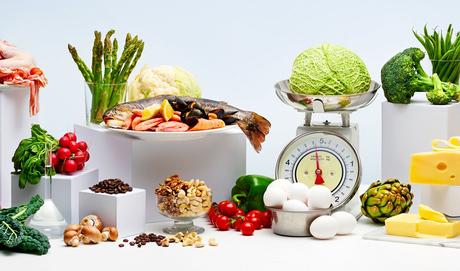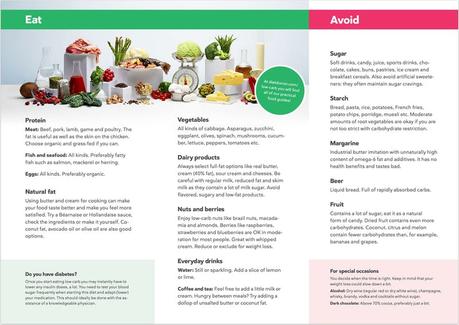
A low-carb diet is low in carbohydrates, primarily found in sugary foods, pasta and bread. Instead, you eat real foods including protein, natural fats and vegetables.
Studies show that low-carb diets result in weight loss and improved health markers, and these diets have been in common use for decades. Best yet, there's usually no need to count calories or use special products - all you need to do is to eat real food.
Learn more about low carb and how to use it for your personal goals here.
2. What to eat on a low-carb diet
In this section you can learn exactly what to eat on low carb, whether you prefer visual guides, detailed food lists, delicious recipes or a simple get started guide.
Let's start with a quick visual guide to low carb. Here are the basic food groups you can eat all you like of, until you're satisfied:

The numbers above are grams of digestible carbs per 100 grams (3.5 ounces). Fiber is not counted, you can eat all the fiber you want.
All foods above are below 5% carbs. Sticking to these foods will make it relatively easy to stay on a strict low-carb diet, with less than 20 grams of carbs per day.
Detailed low-carb foods listTry to avoid
Here's what you should not eat on low carb - foods full of sugar and starch. These foods are much higher in carbs.

The numbers are grams of digestible carbs per 100 grams (3.5 ounces), unless otherwise noted.
What to drink

What drinks are good on a low-carb diet? Water is perfect, and so is coffee or tea. Preferably use no sweeteners. A modest amount of milk or cream is OK in coffee or tea (but beware of caffe latte!).
The occasional glass of wine is fine too.
For more, check out our complete guides to low-carb drinks and low-carb alcohol.
Visual low-carb guides
Here are more detailed visual guides to the amount of carbs in common foods. Is a specific food item low or high in carbs? Click to find out:
Recipes
Browse our over 600 delicious low-carb recipes or head over to our 14-day low-carb meal plan for inspiration. You can always find our recipes under "Recipes" in the top menu. Here are a few popular ones:
Meal plans
Use our premium meal planner tool (free trial) to access tons of weekly meal plans, complete with shopping lists. You can adapt the plans to your liking, skipping any meal, choosing how many people you're cooking for, and the shopping lists adapt. You can even start a new plan from scratch (of from pre-existing ones), tailor them completely and save them.
Here's an example meal plan:
Check out the meal-planner tool
How low carb is a low-carb diet?
The fewer carbohydrates you eat, the more powerful the effects on weight and blood sugar appear to be. For that reason we recommend initially following the dietary advice fairly strictly. When you're happy with your weight and health, you may carefully try eating more carbs (if you want to).
Here are three examples of what a low-carb meal can look like, depending on how many carbs you plan to eat per day:
A strict low-carb diet is often called a ketogenic (or "keto") diet.
Video course

Get started
Keen to get started? Then sign up for our free 2-week low-carb challenge, where you'll be guided step-by-step through your low-carb journey.

Leaflet
Here's a leaflet with basic low-carb advice, that you may want to print and have around, or give to friends who are curious:


Low-carb advice in 40 languages
We have written advice on a low-carb diet in 40 languages, including our full Diet Doctor site in Spanish or Swedish.
 Lose weight
Lose weight

 Reverse type 2 diabetes
Reverse type 2 diabetes

 A grateful gut
A grateful gut

 Reduce sugar cravings
Reduce sugar cravings

All low-carb benefits
4. Low-carb tips and guides
To make a low-carb diet truly simple and enjoyable requires a few new skills. For example, how do you cook low-carb breakfasts that you love? How do you eat more healthy fats? And what's important to think about when dining out?
Here are all the guides you need.
 Breakfast
Breakfast

Breakfast is a great time to eat low carb. Who doesn't love bacon and eggs? In the unlikely event that you answered "I", there are even great options with no eggs at all.
Another strong option is to just have a cup of coffee, as many people get less hungry on a low-carb, high-fat diet and may not need breakfast at all. This can save you plenty of time.
There are many other options - both delicious and fast
 Meals
Meals

So, what's for lunch and dinner on a low-carb diet? You could for example have meat, fish or chicken dishes with vegetables and a rich full-fat sauce. There are a million alternatives.
Check out our recipes to learn to cook amazing low-carb meals
 Instead of potatoes, pasta and rice
Instead of potatoes, pasta and rice

Who needs starchy sides when you can have cauliflower mash or cauliflower rice instead? Not to mention butter-fried green cabbage, yum!
In short, there are lots of great low-carb alternatives to carb-rich foods that are both tasty and healthy
 Eating out
Eating out

It's very possible to eat low carb even when leaving your house, for example at restaurants. Just avoid starchy foods and ask for some extra natural fat (e.g. olive oil or butter).
This guide helps you with tips for fast food, other restaurants, buffets and for when you eat at a friend's house
 Snacks
Snacks

You probably don't need to snack as much on a low-carb diet, as you'll likely feel satisfied longer.
However, if you want something right away you could have cheese, nuts, cold cuts or even an egg. There are lots of amazing options
 Bread
Bread

Do you have a hard time living without bread?
There are good and bad low-carb options. Spoiler: you'll probably want to stay away from "low-carb" bread from the grocery store! Here's why, and what to do instead
 How to eat more fat
How to eat more fat

Fat can be both satiating and an amazing flavor enhancer. But how do you get in enough of it in your diet? And how much fat should you really eat? Hint: enough to feel satisfied and not hungry.
Learn all about it in this guide
 Avoid "low-carb" junk food
Avoid "low-carb" junk food

Many who are eating a low-carb diet can get seduced by creatively marketed "low carb" products - cakes, cookies, candies, chocolate, pastas, breads, ice cream and other substitute foods.
Unfortunately this rarely ends well, especially not for weight loss. These products are usually junk food, and often much higher in carbs than their labels try to imply. Preferably avoid. Learn more
 How to make low carb cheap
How to make low carb cheap

A low-carb diet doesn't have to be expensive. In this guide, you'll learn how to make it cheap.
With a little planning and preparation you could save a ton of money
 Low-carb cheating
Low-carb cheating

Is it a good thing to occasionally cheat on a low-carb diet? That depends. And it's worth thinking about what's right for you. Learn more
More guides
Do you want more low-carb guides? We have more low-carb guides!
All low-carb guides
5. Potential side effects on a low-carb diet
If you stop eating sugar and starch cold turkey (recommended) you may experience some side effects as your body adjusts. For some people these side effects are mild, while others find the transition more difficult. It usually lasts a few days, up to about a week, and there are ways to minimize it.
Another option is to decrease the intake of carbohydrates slowly, over a few weeks, to minimize side effects. But the "Nike way" (Just Do It) may be the best choice for most people. Removing most sugar and starch often results in several pounds lost on the scale within a few days. This may be mostly fluids, but it can still be great for motivation.
Here are side effects that may occur when you suddenly start a strict low-carb diet.
 Induction flu
Induction flu

By far the most common side effect is called the induction flu. It's what makes some people feel really poorly for a few days (up to a week) after starting low carb.
Here are common symptoms:
- Headache
- Fatigue
- Dizziness
- Nausea
- Irritability
These side effects rapidly subside as your body adapts and your fat burning increases. Within a week, they are usually gone.
The primary reason for this may be that carbohydrate-rich foods can increase water retention in your body. When you stop eating high-carb foods you'll lose excess water through your kidneys. This can result in dehydration and a lack of salt during the first week, before the body has adapted, resulting in the symptoms above.
You can minimize the induction flu by drinking more fluids and by at least temporarily increasing your salt intake. A good option is to drink a cup of bouillon/broth one or two times a day. This usually keeps the induction flu minor or even non-existant.
Alternatively, drink a few extra glasses of water and put more salt on your food.
Learn more about induction flu and how to treat itOther common issues on low carb
Beyond the induction flu, there are six more relatively common side effects on a low-carb diet. It seems like many of them can also be mostly avoided by getting enough fluid and salt.
There are also more things you can do to minimize any problems, click to read more if you've experienced one of these issues:
Less common issues
These are less commonly noticed issues, that generally only affect a minority of people:
All low-carb side effects and how to cure themLow-carb controversies
Beyond the mostly transient side effects that may occur on a low-carb diet (see above) there are many controversies, misunderstandings and a few pure myths that simply don't hold up to closer scrutiny. For example, your brain is supposed to stop working unless you eat carbs. We'll, that's simply wrong.
Read all about these topics on our low-carb controversies page, or choose a specific topic below:
6. Learn more
Here's the sixth and final section of this low-carb page. Do you want to truly understand low carb, and get answers to your remaining questions? Or do you want extra inspiration for yourself or for people you're trying to help?
Find it here, and start becoming a low-carb expert.
 Low-carb TV
Low-carb TV

Get insight, enjoyment and inspiration to help you succeed, from the top low-carb channel on the planet.
Select from hundreds of awesome videos, and we're adding 2-4 more new ones every week. Enjoy! The service is only available for members, but we offer a free trial. Join free for a month
 How low carb works
How low carb works

What are you designed to eat, and why can sugar and starch be a problem? Essentially, how does a low-carb diet work?
Learn how low carb works Scientific studies on low carb
 Questions and answers
Questions and answers

Are you having problems on low carb? Are you not losing weight like you want to? How many carbs should you eat?
Get answers to your low-carb questions
 Why fat is your friend
Why fat is your friend

A lot of people still fear natural fat. But really, the whole idea that we should fear fat is based on a scientific mistake, and many open-minded experts now admit it.
Just witness the recent TIME cover to the right, with the text "Eat Butter. Scientists labelled fat the enemy. Why they were wrong."
Learn more about cholesterol and why fat is your friend
 Upcoming low-carb events
Upcoming low-carb events

Do you want to learn much more, and meet experts and other people who are interested in low carb? Here's a current list of upcoming low-carb conferences and other events.
The Food Revolution
Do you want a summary of the ongoing food revolution? From failed low-fat diets and an epidemic of obesity and diabetes, through a growing realization of our mistakes, and towards a potential health revolution.
Watch this talk by Dr. Andreas Eenfeldt, the founder of Diet Doctor:
Next
You've reached the end of this page (congratulations!). Keep reading about what to eat on a low-carb diet
Don't miss





